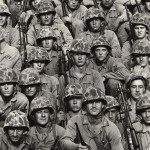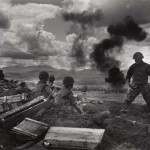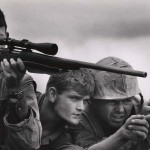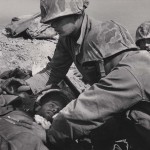[Read more…] about Listening closely to the Ezra Pound radio controversy
World War II
World War II-era Armed Services Editions boosted troop morale and fostered a new generation of readers
The book, When Books Went to War: The Stories That Helped Us Win World War II by Molly Guptill Manning, celebrates the importance of the Armed Services Editions. Published between 1943 and 1947, these inexpensive paperback editions were given to servicemen on the frontlines. As Manning points out, not only did the editions achieve their principal purpose of raising morale, they encouraged a whole generation of readers who retained their appetite for reading when they returned home. Possibly a few stopped bullets or shrapnel. It’s necessary to remember that the cheap paperback edition was still a novelty at the beginning of the war, having been pioneered by Penguin Books in England and Albatross Books in Germany during the 1930s.
Armed Services Editions were made possible by a group of publishers called the Council of Books in Wartime. This group collaborated by eliminating royalty payments and arranging for the production and distribution of paperbacks in the most inexpensive possible formats. The Ransom Center has a couple of connections with these books. Although there are larger collections at the University of Virginia and the Library of Congress, we own more than 1,400 of the books, most of them shelved together as a discrete collection in the stacks, while some are kept with other editions of our major authors, such as John Steinbeck. Because they were printed on poor-quality wartime paper that is now brittle and brown, each is protected in a simple acid-free enclosure, invented by the Center’s Conservation department in the 1980s, and called a “tuxedo case.” Students of publishing history can use the collection to study which books were most successful (Manning concludes that books with a touch of nostalgia or sex were particularly popular with soldiers, and F. Scott Fitzgerald’s The Great Gatsby was one of the best-selling titles, even though it was considered a flop when first published in hardback during the 1920s). The books were generally published in an oblong format, with the cover notation “This is the complete book—not a digest.” In all, some 125 million copies were produced.
Among the founding members of the Council of Books in Wartime was Alfred A. Knopf, the eminent literary publisher (the massive Knopf, Inc. archive is here at the Center). Ironically, Knopf was famous for encouraging high production values in his own trade books, but he immediately recognized the importance of encouraging reading and raising morale and contributed a number of series titles by familiar authors in the Knopf stable, including thrillers by James M. Cain and Raymond Chandler and more literary works by Thomas Mann and Sigrid Undset.
In the postwar era, a number of paperback reprint publishers capitalized on increased demand for books, the availability of new outlets for cheap editions, such as chain department stores and drugstores, and Americans’ newly enhanced disposable income. Pocket Books debuted in 1939 and became well known after the war for its lurid covers, which, as Louis Menand points out in an illustrated recent New Yorker piece, graced not only the unabashed pulp of Mickey Spillane but also higher-toned works by William Faulkner and James Joyce. Ballantine and Bantam editions flourished, and the era of the mass market paperback had arrived. Nearly every prominent American hardback publisher developed a line of paperback books. Oddly, Knopf, Inc. was a holdout, arriving late to the game with Vintage Books in 1956. But it was the Armed Services Editions that gave the American paperback its big push.
Please click on thumbnails below to view larger images.
Veterans Day conversation with photojournalist (and Marine) David Douglas Duncan
The Ransom Center holds the archive of American photojournalist and author David Douglas Duncan, including his images of World War II and the Korean and Vietnam wars. In honor of Veterans Day, Ransom Center Research Curator of Photography Roy Flukinger asked Duncan about photography, being a Marine, his experiences as a combat photographer, and his prediction about the next generation of war photographers. Below are Duncan’s responses, submitted in writing from his home in France.
Materials from Duncan’s archive can be seen in the Ransom Center’s online exhibition. More than 50 of Duncan’s photographs of Pablo Picasso and Jacqueline Roque are currently on view in New York City in the Pace Gallery’s exhibition “Picasso & Jacqueline: The Evolution of Style.”
So many of today’s photojournalists are civilians with media credentials. In contrast, during many of the conflicts that you covered, you were a Marine, first on active duty and then as a veteran, working as a combat photographer. How would you characterize the critical difference this has made in your photography and in working with military personnel?
As a Marine I always worked alone, my notes for every shot plugged into my memory—never a notebook. All of the guys around me were Marines, and, as we all knew, if one got zapped, other vertical guys would somehow get you out—to be patched up or shipped home.
Today, much of the memorable coverage has been shot by amateurs with cell phones, not Washington/Army “implanted” pros—think Abu Gharib.
You wrote in This Is War! that “There is neither climax nor conclusion to this book.” And you repeated the phrase in the foreword to your Vietnam book, War Without Heroes. Having now completed decades of covering numerous conflicts throughout the globe, would you say that the same statement is appropriate to describing all wars and that future combat photographers will also find it impossible to tell the whole story?
There is no “whole story” in combat photography—only fragments of each moment that sometimes/often seems like eternity… and in that jungle, on that strip of obscene discolored far-from-home sand, the Marine at your shoulder is your only relative in that world—unlike no other but still precious and even long-loved by those who survived to come home to the world where almost every combat Marine is often a stranger even among his own family and friends… and then, confined to a veteran’s bed where the nights were often worse than that sandy beach or sodden jungle fox-hole where it was still possible to dream of everything, including tomorrow.
The men who fought the battles, who lived and died, who shared the service alongside you are clearly more than just the subjects of your camera. When we hung your exhibition and looked through your books you frequently recalled their names and shared many anecdotes about them. And the ones I met certainly remembered you. Is this a special relationship that is shared between veterans, that goes beyond just the basic reportorial dimensions of your picture stories?
One would doubt that other lives are so enriched as those of the Marines who were my combat friends…. yet, say among many lifelong career pros, the Formula One race drivers where everything can explode in fractions of a second… where they are wheel-to-wheel at 300 kilometers-an-hour and sure of the other driver’s professionalism and nerves under constant lethal pressure… yes, there must be other lives similar where the risks and lifelong friendships could well be similar to those of veteran Marines.
You revolutionized your field with the adoption of Nikon lenses and later technological advances.Have the digital and electronic changes we have witnessed in the last generation of photojournalism made it easier or harder to tell the story of war correctly and fully?
Digital cameras/smart phones even iPads, as seen everywhere, among tourists, children, hobbling ancients, workmen everywhere reporting back to control offices somewhere faraway—everybody is a photographer today. No sweat—and many among that digital-loaded horde are very, very good photographers, having fun—their generation/taking it for granted and surely filling souvenir books at home sometimes/possibly often holding masterpieces.
You have already provided us with a lifetime of words and photographs on the subject. Are there other aspects of the story of war that you might wish to see the next generation of combat photographers address more completely on future Veterans Days?
The next generation of war photographers? ……drones!










